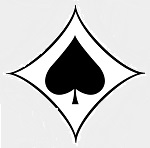Hobby Master HA8712 German Messerschmitt Bf 109E-3 "Emil" Fighter - Gruppenkommandeur Werner Molders, III./Jagdgeschwader 53 "Pik As", May 1940 (1:48 Scale)
"As England, in spite of her hopeless military situation, still shows no signs of willingness to come to terms, I have decided to prepare, and if necessary to carry out, a landing operation against her. The aim of this operation is to eliminate the English Motherland as a base from which the war against Germany can be continued, and, if necessary, to occupy the country completely."
- Fuhrer Directive No. 16, announcing Unternehmen Seelowe (Operation Sea Lion), the invasion of England, July 16th, 1940
 Numerically the most abundant fighter produced by either side during WWII, the Messerschmitt Bf 109 formed the backbone of the Jagdwaffe on both the eastern and western fronts, as well as in the Mediterranean and North Africa. Of the eight distinct sub-types within the huge Bf 109 family, the most populous was the G-model, of which over 30,000 were built between 1941-45. Despite its production run, only a handful of genuine German Bf 109s have survived into the 1990s, and with the serious damaging of the RAFs G-2 at Duxford in October 1997, only the German-based MBB G-6 and Hans Ditte's G-10 (both composites) are currently airworthy.
Numerically the most abundant fighter produced by either side during WWII, the Messerschmitt Bf 109 formed the backbone of the Jagdwaffe on both the eastern and western fronts, as well as in the Mediterranean and North Africa. Of the eight distinct sub-types within the huge Bf 109 family, the most populous was the G-model, of which over 30,000 were built between 1941-45. Despite its production run, only a handful of genuine German Bf 109s have survived into the 1990s, and with the serious damaging of the RAFs G-2 at Duxford in October 1997, only the German-based MBB G-6 and Hans Ditte's G-10 (both composites) are currently airworthy.
The first redesign came with the E series, including the naval variant, the Bf 109T (T standing for Trager, carrier). The Bf 109E "Emil" introduced structural changes to accommodate the heavier and more powerful 1,100 PS (1,085 HP) Daimler-Benz DB 601 engine, heavier armament and increased fuel capacity. Partly due to its limited 300 km (186 mile) combat radius on internal fuel alone, resulting from its 660 km (410 mile) range limit, later variants of the E series had a fuselage ordnance rack for fighter-bomber operations or provision for a long-range, standardized 300 litre (79 US gallon) drop-tank and used the DB 601N engine of higher power output. The 109E first saw service with the "Condor Legion" during the last phase of the Spanish Civil War and was the main variant from the beginning of World War II until mid-1941 when the 109F replaced it in the pure fighter role.
Pictured here is a 1:48 scale replica of a German Messerschmitt Bf-109E-3 "Emil" fighter that was flown by Gruppenkommandeur Werner Molders, who was attached to III./Jagdgeschwader 53 "Pik As" ("Ace of Spades") during May 1940.
Sold Out!
Dimensions:
Wingspan: 8-inches
Length: 7-1/2-inches
Release Date: June 2017
 Historical Account: "100 Victories" - Werner Molders (March 18th, 1913 - November 22nd, 1941) was a German Luftwaffe pilot. He was the leading German fighter ace in the Spanish Civil War; in World War II, he became the first pilot in aviation history to claim 100 aerial victories - "that is, 100 aerial combat encounters resulting in the destruction of the enemy aircraft. The highly decorated Molders was instrumental in the development of new fighter tactics which led to the finger-four formation. He died in the crash of an airplane in which he was a passenger.
Historical Account: "100 Victories" - Werner Molders (March 18th, 1913 - November 22nd, 1941) was a German Luftwaffe pilot. He was the leading German fighter ace in the Spanish Civil War; in World War II, he became the first pilot in aviation history to claim 100 aerial victories - "that is, 100 aerial combat encounters resulting in the destruction of the enemy aircraft. The highly decorated Molders was instrumental in the development of new fighter tactics which led to the finger-four formation. He died in the crash of an airplane in which he was a passenger.
Molders joined the Luftwaffe in 1934 at age 21. In 1938, he volunteered for service in the Condor Legion, which supported General Francisco Franco's Nationalist Falange in the Spanish Civil War, and shot down 15 aircraft. In World War II, he lost two wingmen in the Battle of France and the Battle of Britain, but shot down 53 enemy aircraft. With his tally standing at 68 victories, Molders and his unit, the Jagdgeschwader 51 (JG 51), were transferred to the Eastern Front in June 1941 for the opening of Operation Barbarossa. By the end of June 22nd, 1941, the first day of Barbarossa, he had added another four victories to his tally; a week later, he surpassed Manfred von Richthofen's 1918 record of 80 victories.
Prevented from flying further combat missions for propaganda reasons, at the age of 28 Molders was promoted to Oberst, and appointed Inspector General of Fighters. He was inspecting the Luftwaffe units in the Crimea when he was ordered to Berlin to attend the state funeral of Ernst Udet, the World War I flying ace. On the flight to Berlin, the Heinkel He 111 in which he was travelling as a passenger encountered a heavy thunderstorm during which one of the aircraft's engines failed. While attempting to land, the Heinkel crashed at Breslau, killing Moders and two others. The German Wehrmacht of the Third Reich and the Bundeswehr of the Federal Republic of Germany both honored him by naming two fighter wings, a destroyer and barracks after him. In the 1970s-1990s, he became part of a broader discussion in Germany over remembering the Holocaust and honoring decorated soldiers of the Third Reich.


